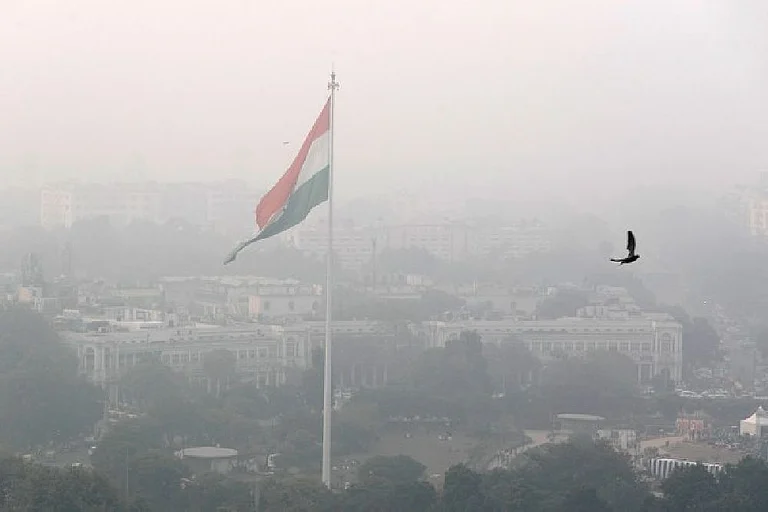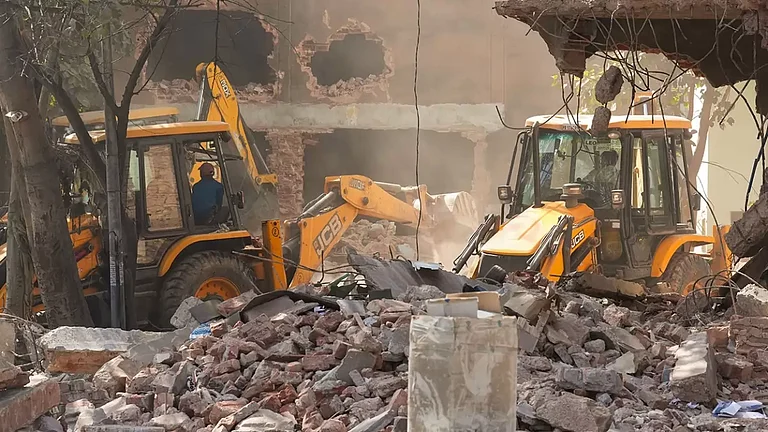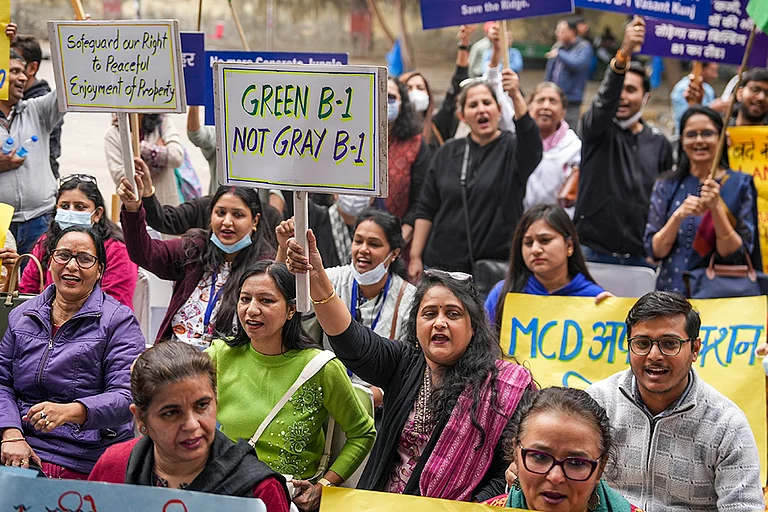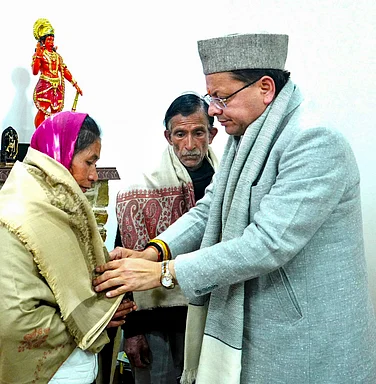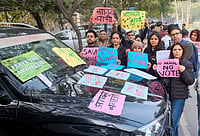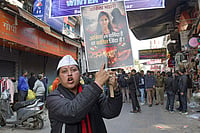While hammers and bulldozers pound down homes that stood for decades, the urban poor grieve the loss of shelter and community. The once vibrant lanes are now a lifeless expanse of rubble and dust, a stark contrast to the gleaming new towers rising in the distance where a few were rehabilitated. Yet, those who were described as "ineligible" remained huddled under the unforgiving sun in makeshift shelters of rags and salvaged wooden planks.
In this silence, construction labourers arrived to pick through the debris, bargaining with residents who sell the very bricks of their demolished houses to make ends meet. Others simply sit, clutching old ration cards and voter IDs, wondering how the same documents that secured them an address during election season are suddenly declared “faulty” or “incomplete” when they seek rehabilitation and resettlement.
On the final leg of Delhi’s election campaign in February this year, Prime Minister Narendra Modi declared at a rally that under the “double-engine government,” “Dilli mein ek bhi jhuggi nahi tootegi”—not one slum would be demolished in Delhi.
Yet on June 11, 300 jhuggis in Govindpuri’s Bhoomiheen Camp were reportedly razed to the ground. In Ashok Vihar, the Delhi Development Authority (DDA) demolished 200 illegal structures in the Jailorwala Bagh area. Earlier, on June 1, at least 300 structures in the Madrasi Camp slum cluster in Jangpura were levelled.
The promise of protection and support seems hollow in the face of eviction drives often carried out with little prior notice. The destruction is more than the loss of physical walls—it is the erasure of identity, community ties, and any sense of security residents once had.
Does the Law Protect Basti Residents?
While laws protecting jhuggi jhopdi (JJ Bastis) residents remain in place, a series of judgments have created obstacles that make it harder for displaced people to secure their rights.
“The legal framework has not changed, it is the respect for the legal framework that has changed,” said Talha Abdul Rahman, an Advocate-on-Record at the Supreme Court who represented some of the residents in the case.
After the landmark 2010 judgment in Sudama Singh v Government of Delhi, the court affirmed that the right to housing is a fundamental entitlement and ruled that slum residents must not be treated as second-class citizens. It required authorities to engage in genuine dialogue with affected communities prior to any eviction and instructed the government to develop a clear and comprehensive policy for rehabilitation.

Following this, with the mandate to improve the living conditions of the slum dwellers, the Delhi Urban Shelter Improvement Board (DUSIB) was constituted on July 1, 2010.
“DUSIB is primarily responsible for improving the quality of the life of Slum & JJ Dwellers in the capital city of Delhi whose population at present is estimated to be 1.40 crores,” the website states, adding that at least 30 lakh are living in approximately 6 lakh jhuggis whose shelter and social infrastructure inputs are becoming “serious and increasing concern of Government.”
Then came the 2015 Delhi Slum & JJ Rehabilitation and Relocation Policy, which defined the eligibility criteria for rehabilitation and rights. “The 2015 policy says that your basti has to be in existence prior to 2006 and your house in that basti has to be in existence prior to 2015.” said Anupradha Singh, an Advocate at Nyay Neeti Foundation.
She added that the definition of basti is also mentioned, which says that a basti should have at least a minimum of 50 number of households existing as of 2006 to be considered a JJ Basti.
The 2015 Rehabilitation Policy
In Vaishali (Minor) v. Union of India, the Delhi High Court held that the 2015 rehabilitation policy applied exclusively to residents of the 675 slum clusters listed by the Delhi Urban Shelter Improvement Board—a list reportedly prepared nearly thirty years ago.
As per Rahman, this is where the trouble cements. He said, what the courts “unfortunately” understood is that only these people were entitled to rehabilitation, not that others are also to be given rehabilitation. Only that the enlisted people have a stronger quality of right.
“The DDA and central governments efforts are to show that you were not a basti before 2006 or that you are not a resident before 2015.”
The first was used in the Sunder Nursery basti demolition, he said. Despite crores of rupees spent on cobbled roads and toilets, “DUSIB and LNDO (Land and Development Office) convinced the court that there was no basti there, through satellite photos.” There is a limitation with satellite photos since granularity may not show bastis well.
He added that how the law works is not through satellites but through physical verification on site; and DUSIB had spent money on the basti. “So you couldn't say that the basti didn't exist but the court stepped outside the statutory regime to say that we will go by satellite images.”

Difficulty in Locating Documentation
Another issue with the rehabilitation process arises from the 12 documents listed to establish eligibility. The policy is inconsistent, Singh explained, because while it states that any of these 12 documents can be used as proof, in other place it mandates that one must have a voter ID card or a ration card.
“There is a population cap and the Delhi government is saying that because the population is maxed out, new ration cards cannot be issued.” The Delhi Government has not issued ration cards in almost a decade, she said.
These are minor issues over discrepancies of documents for which relief can be provided, but the policy is being used against the ones seeking rehabilitation, said Hari Shankar, a social worker associated with the demolitions in Bhoomiheen Camp. “The surveys that should have been done by government officials were done by 17-year-olds. There is plenty of corruption in the process.”
These claims were resounded by Rahman, who said that the Bhoomiheen survey was done by a third party private. “DDA does not have the competence, DUSIB is the one competent and authorized to do the survey.”
He said that surveys are not just questions and answers but anthropological studies, and justice is not being done since DUSIB seems to be working under the influence of DDA. “They reach for a survey without prior notice. The daily wage labourers are away for work, they lock up behind them. They lose their earning of the day.”
Rehabilitation claims of some residents were strategically dismissed because of their commercial activities in the basti, while families living on different floors in the basti are provided with just one alternate flat, said Kaoliangpou Kamie, who is representing the Bhoomiheen complainants.
The policy also states that “DUSIB shall provide alternate accommodation to those living in JJ Bastis, either on the same land or in the vicinity within a radius of 5 kilometer.” Contrary to that, Rahman pointed out that after the Kali Bari demolition, the residents were told that they would rehabilitate in Dwarka but later DDA moved them to Narela.
He added that when the DDA does not have land available within the 5-kilometer radius, the DUSIB has the authority to decide where the land should be allotted. The underlying principle, he explained, is that if the 5-kilometer criterion cannot be met, the next best option is land within 6 kilometers, and so on.
“They jumped from 5 kilometers to 40 kilometers in Narela. Why? Because they had some unclaimed flats. There were no takers for that flat so they gave it to the poor to occupy.” Rahman said, adding that DDA is not working like a welfare state, with no consideration for the commute time of people being moved.
Politically Motivated?
Notwithstanding anything contained in the DDA law, the colonies also had to be regularised, for which The National Capital Territory of Delhi Laws (Special Provisions) Second Act, 2011 was passed. It mentioned that “no action will be taken, even if there is an order, it should not be given effect,” Rahman said.
The stature understood the problem and it was thought that the 2015 policy was the “proper solution and now all of these slums will be gradually converted into in-situ accommodation for the slum dwellers.”
He said the developments were on track till 2019. Katputli Colony had been redeveloped on this model.
“But in post-COVID times, especially in the last two-three years, they decided these poor people are not going to vote for the government in power, therefore, let us get rid of them. And immediately, swiftly, after their demolition, their names are also stuck off from the electoral list. So, no house, no vote, finish.”
Singh added that it is a way to disenfranchise the poor people, adding that “We definitely can't say the courts are politically motivated. But yes, the demolitions which are happening, one can maybe conjecture that these are politically motivated because certain communities are being targeted, certain areas are being targeted.”
A Fresh Survey Needed?
There needs to be a fresh survey ascertaining the number of JJ bastis in the capital, as the current stats seems exclusionary, Singh said, adding that there are a multitude of problems with the current approach.
“According to the Ajay Maken Judgement, which was passed by the Delhi High Court in 2019, they have mentioned a survey by NSSO (National Sample Survey Office) in 2012 which stated that there were more than 6000 slums.”
Furthermore, the 2006 freezing date is outdated. “We're also saying that the 50 number of households for Juggi Jhopdi Basti is also very exclusionary because there are a lot of people, who are residing on the footpaths and they've been living there for 30 to 60 years also. And these are 20, 25, 30 in number, but they are again excluded from the policy because it says that there has to be at least 50 households.”
The government should also focus on slum upgradation, in situ rehabilitation and some relaxation on the document part, she added.
The Bhoomiheen case is with the Chief Justice of India, and is scheduled for July 29. “The hearing will affect every case. Because the legal issue of documents is being decided or whether one is eligible for rehabilitation if they are residing on the first floor,” Singh said.









